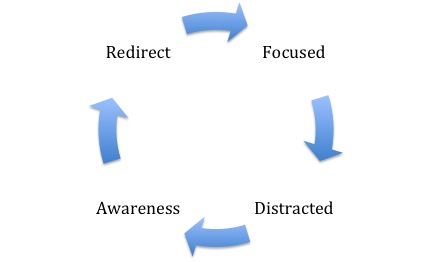Note: This is the first post in my 3-part “Introduction to Mindfulness” series.
These days, much of our stress has to do with our thoughts about situations. Ideally, when we are faced with a problem, we will do all we can in the moment to solve it and let it go. What happens more often, though, is that we continue to think about and worry about a stressful situation, which causes the stress to become chronic. We get a certain amount of stress from the situation itself, and then add a lot of stress by how we think about it and respond to it.
Mindfulness meditation is a proven practice to help reduce stress. Mindfulness is a practice of focusing your attention in a particular way – nonjudgmentally paying attention to experiences in the present moment. Most of the time, our minds tend to be focused on what has happened in the past or what may happen in the future. Often, these thoughts run continually in the back of our minds, like a running commentary – we usually don’t even realize they are happening. These thoughts can have a huge impact on our stress levels, though.
Mindfulness meditation is a way to train our minds to become more aware of what we are thinking about in the moment and to learn to avoid getting caught up in the thoughts and let them get out of control, causing more stress than is necessary.
To be clear, mindfulness is not about trying to stop having thoughts, or changing your thoughts. It’s simply about recognizing “thinking” and being in the present. With regular practice, mindfulness can actually rewire the brain – changing the physical structure – to make it easier to focus your thoughts in ways that reduce the impact stressful situations have on you.

Here’s how it works:
Focus: you begin by focusing your attention on your experience of the present moment. The best way to do this is to focus on your senses – since you sense things in the present moment and your thoughts are about things in the past or the future – not in the present.
So you can start by focusing on your experience of something like your breath – focusing on how it feels in your body as you breathe in and out. That’s the top of the circle.
Distracted: After a bit, your mind will become distracted and start thinking about stuff. It will probably be distracted a bit before you even realize you are distracted.
Awareness: Eventually you become aware of the fact that you are having thoughts and have become distracted from just experiencing the present moment.
Redirection: This is a critical step: without judging yourself for the content of the thoughts, you just label them as “thoughts” and let them go, coming back to experiencing the breath.
And the cycle begins again.
The point of the practice isn’t to stay focused on the breath the whole time. The point is to become more aware of your thoughts and to learn to gain control of where your mind goes when it gets off track. You might go through the cycle several times a minute, and that’s OK. The intention is just to practice going through the process of focusing, getting distracted and re-focusing. With practice, this becomes easier.





